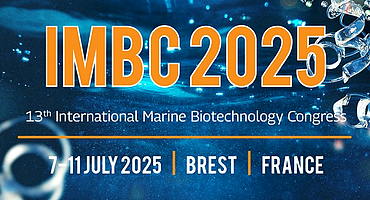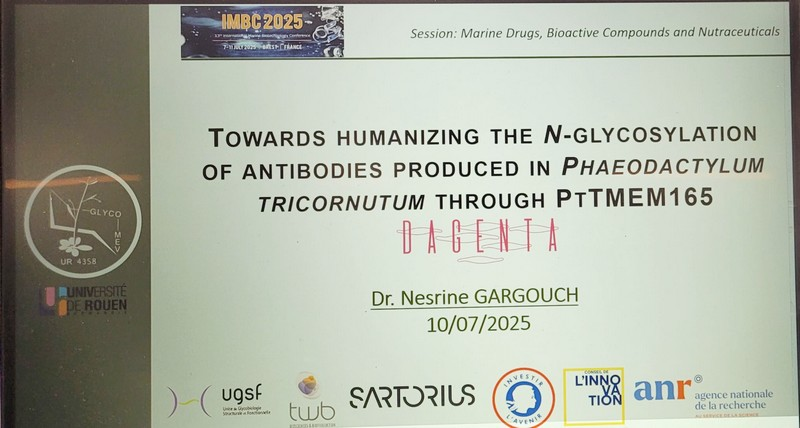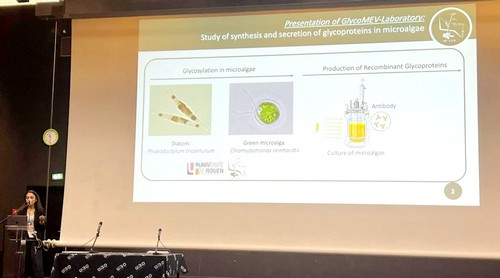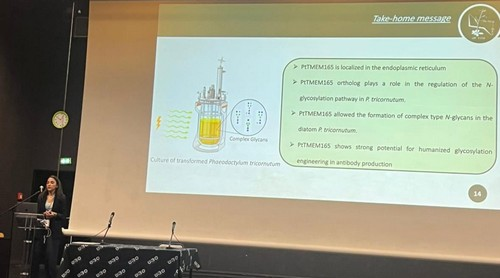IMBC 2025

La 13ème édition de l'International Marine Biotechnology Congress s'est déroulée du 7 au 11 juillet 2025 à Brest, et a réuni les leaders mondiaux en biotechnologies marines, avec pour objectif de faciliter les échanges entre étudiants, chercheurs, technologues, décideurs et industriels, autour de conférences et de posters sur les avancées scientifiques dans les domaines des sciences marines, de la biologie moléculaire, de l’ingénierie et des technologies de l’information destinés à la meilleure compréhension des écosystèmes marins.
A l'occasion de cette rencontre, le Dr Nesrine GARGOUCH, qui représentait le Laboratoire GlycoMEV, a donné une conférence sur les travaux de recherche du Projet DAGENTA intitulée :
« Towards Humanizing the N-glycosylation of Antibodies Produced in Phaeodactylum tricornutum through PtTMEM165. »
Nesrine Gargouch, Magali Siaut, Mélissandre Herbaut, Vianey Deleplace, Dominique Legrand, Sylvain Julien, Fayza Daboussi, François Foulquier, Muriel Bardor
Résumé :
Microalgae are emerging as promising cell factories for producing complex recombinant proteins, such as monoclonal antibodies. However, optimizing the effector functions of antibodies produced by these microalgae for therapeutic applications underscores the need for optimizing the N-glycosylation pathway. In this context, the present study focuses on investigating N-glycosylation in Phaeodactylum tricornutum to produce antibodies with a human-like glycosylation pattern.
Recent insights into mammalian cells reveal that the biosynthesis of complex-type N-glycans is regulated by manganese ion homeostasis, with the involvement of the transmembrane protein TMEM165. It has been demonstrated that defects in this protein led to Golgi glycosylation abnormalities, notably hypogalactosylation and hyposialylation.
Recently, we identified an ortholog of TMEM165 named PtTMEM165 in P. tricornutum, strongly suggesting its potential role in regulating Golgi N-glycosylation. To assess PtTMEM165's function and role, we conducted heterologous complementation in HEK KO TMEM165 deficient cell line, generated TMEM165-deficient P. tricornutum lines using CRISPR-Cas9, and overexpressed PtTMEM165 in wild-type P. tricornutum cells. Such experiments allowed us to demonstrate 1-that PtTMEM165 is able to restore a normal glycosylation profile in HEK cells and 2-the overexpression of PtTMEM165 facilitated the synthesis of N-glycans containing N-acetylglucosamine residues at the terminal position. Additionally, subcellular localization studies in HEK cells revealed that PtTMEM165 predominantly localizes to the endoplasmic reticulum. The phenotypic alterations of P. tricornutum cells lacking TMEM165 activity are under studied.
In conclusion, this study advances our understanding of PtTMEM165's role in P. tricornutum N-glycosylation and highlights its potential for engineering humanized glycosylation pathways to produce antibodies.



Participation de Nesrine Gargouch
![]()




 Adresse : 1er étage Bâtiment CURIB, Place E. Blondel, UFR Sciences et Techniques - Université de Rouen Normandie, F-76821 Mont Saint-Aignan CEDEX France
Adresse : 1er étage Bâtiment CURIB, Place E. Blondel, UFR Sciences et Techniques - Université de Rouen Normandie, F-76821 Mont Saint-Aignan CEDEX France Téléphone Secrétaire administrative : +33 (0)2 35 14 63 56
Téléphone Secrétaire administrative : +33 (0)2 35 14 63 56 E-mail Secrétaire administrative :
E-mail Secrétaire administrative : 

